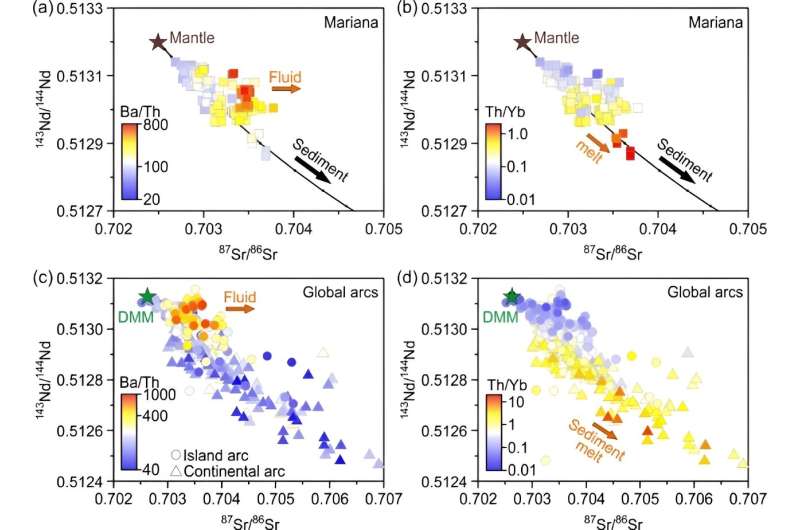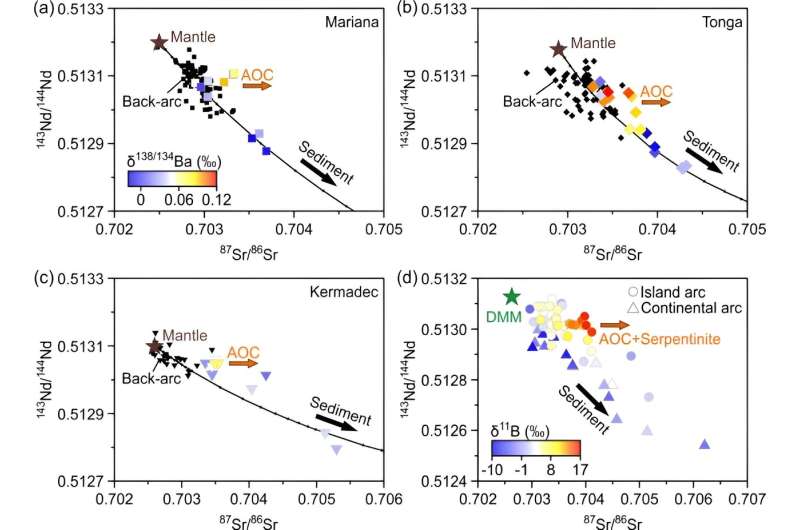This article has been reviewed according to Science X's editorial process and policies. Editors have highlighted the following attributes while ensuring the content's credibility:
fact-checked
peer-reviewed publication
trusted source
proofread
Altered oceanic crust may contribute to arc magmas

As an important subduction component, altered oceanic crust (AOC) is widely distributed on the oceanic subducting slab and may contribute significantly to the chemistry of arc magmas. However, identifying this contribution in arc magmas is challenging because AOC is not as enriched in incompatible elements as sediments, nor does it have as high H2O concentrations as do serpentinites. Therefore, it is necessary to find a sensitive tracer for subducted AOC.
Dr. Zhang Yuxiang of Prof. Zeng Zhigang's team from the Institute of Oceanology of the Chinese Academy of Sciences (IOCAS), together with Prof. Turner Simon from Macquarie University and Prof. Huang Fang of University of Science and Technology of China, found that a combination of Ba-Sr-Nd isotopes could effectively identify the presence of recycled AOC in arc magmas.
The study was published in Journal of Geophysical Research: Solid Earth.
A characteristic geochemical feature of AOC is the decoupling of its Sr-Nd isotopes, i.e., compared with unaltered oceanic crustal rocks, AOC has higher 87Sr/86Sr but similar 143Nd/144Nd. Accordingly, AOC differs from the mantle array in the Sr-Nd isotope plot.
Interestingly, this feature of Sr-Nd isotope decoupling is commonly observed in intra-oceanic arc rocks. Thus, many researchers consider the Sr-Nd isotope decoupling as an indicator of the contribution of recycled AOC. However, before drawing this conclusion, it is necessary to eliminate the influence of sediment-derived melt or fluid.

In this study, the researchers compiled the Sr-Nd isotopes and concentrations of Ba, Th, Yb for global arc rocks. They found that the magnitude of Sr-Nd isotope decoupling of arc rocks is positively correlated with Ba/Th, but negatively correlated with Th/Yb, suggesting that the Sr-Nd isotope decoupling is not related to sediment contributions.
In addition, they found that the arc rocks with more pronounced Sr-Nd isotope decoupling tend to have higher Ba isotope ratios, which is also a feature of the AOC-derived fluid; more importantly, this phenomenon occurs in many subduction zones such as Mariana, Tonga, and Kermadec.
Therefore, a strong link can be established between subducted AOC, heavy Ba isotope compositions, and the Sr-Nd isotope decoupling signature in island arcs, providing a powerful tool for tracking the AOC recycling in subduction zones.
Furthermore, the researchers found that on a global scale, the magnitude of Sr-Nd isotope decoupling is positively correlated with the B isotope ratio, which is an effective tracer for subducted serpentinite.
"This means that subducted AOC and serpentinite may have coupled behaviors during slab dehydration, which has great significance for understanding the material transfer in subduction zones," said Dr. Zhang Yuxiang, first author of the study.
More information: Yuxiang Zhang et al, Deciphering Contribution of Recycled Altered Oceanic Crust to Arc Magmas Using Ba‐Sr‐Nd Isotopes, Journal of Geophysical Research: Solid Earth (2024). DOI: 10.1029/2023JB028407
Journal information: Journal of Geophysical Research
Provided by Chinese Academy of Sciences




















